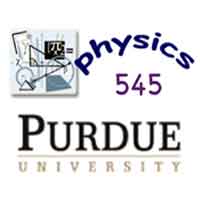Lecture 21: Mean Field Approach to Ferromagnetism
We started off today with a demonstration of Barkhausen Noise in ferromagnets.
(Your refrigerator magnets are ferromagnets.) If you've ever used a permanent magnet to magnetize a paperclip, you know that not all magnetic materials have a discernible north and south pole. Rather, as with paperclips, many ferromagnets have instead a "domain structure" -- there are many regions in the paperclip which are magnetized, but the many domains point in different directions, and the paperclip doesn't act like a permanent magnet. But you can magnetize it, by rubbing it with a permanent magnet. As you do so, you align domains. We used the Barkhausen experiment to hear the domains flip! We wound a pickup coil (lots of wire loops) around the object to be magnetized, and hooked the wire up to a speaker. You can find out more about this setup at www.simscience.org.
We also passed around magnets of various strengths. The weakest magnets were transition metal based (like iron), because the individual magnetic moments are weak. The strongest moment was neodymium-based. Neodymium (Nd) has a large magnetic moment, because it has unfilled f-shells. These and other "rare earth" magnets are surprisingly strong, and pinch your finders if you're not careful! You can buy your own rare earth magnets to play with at Edmund Scientifics.
Then we discussed the mean field theory of ferromagnetism. Mean fields aren't cruel.
What we mean is "average", in the sense that each spin in the system feels an average, effective field due to its neighboring spins. This modifies our equations for magnetization, and we're able to show using this "mean field theory" that when ferromagnets form as temperature is lowered from the disordered paramagnetic phase, the magnetization rises continuously.
Lecture Audio
(Your refrigerator magnets are ferromagnets.) If you've ever used a permanent magnet to magnetize a paperclip, you know that not all magnetic materials have a discernible north and south pole. Rather, as with paperclips, many ferromagnets have instead a "domain structure" -- there are many regions in the paperclip which are magnetized, but the many domains point in different directions, and the paperclip doesn't act like a permanent magnet. But you can magnetize it, by rubbing it with a permanent magnet. As you do so, you align domains. We used the Barkhausen experiment to hear the domains flip! We wound a pickup coil (lots of wire loops) around the object to be magnetized, and hooked the wire up to a speaker. You can find out more about this setup at www.simscience.org.
We also passed around magnets of various strengths. The weakest magnets were transition metal based (like iron), because the individual magnetic moments are weak. The strongest moment was neodymium-based. Neodymium (Nd) has a large magnetic moment, because it has unfilled f-shells. These and other "rare earth" magnets are surprisingly strong, and pinch your finders if you're not careful! You can buy your own rare earth magnets to play with at Edmund Scientifics.
Then we discussed the mean field theory of ferromagnetism. Mean fields aren't cruel.
What we mean is "average", in the sense that each spin in the system feels an average, effective field due to its neighboring spins. This modifies our equations for magnetization, and we're able to show using this "mean field theory" that when ferromagnets form as temperature is lowered from the disordered paramagnetic phase, the magnetization rises continuously.
Lecture Audio

